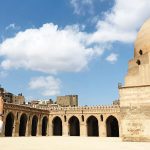Ibn Tulun Mosque
Ibn Tulun Mosque The golden city of Cairo is filled with incredible marvelous
examples of Islamic heritage and culture but nothing like the immortal Ibn
Tulane mosque the father of inspiration and innovation as shown across history.
The mosque changed the face of architecture across the entire Islamic world but was also able to cross to other borders and different cultures.
History of Ibn Tulun Mosque
Ibn Tulun mosque is known for being the best-preserved mosque in Egypt,
Cairo’s oldest intact functioning Islamic monument, and one of the most
important historical and architectural achievements in Muslim civilization.
It was built by the Emir Ahmed Ibn Tulun who ruled Egypt from 868 to 883
A.D under the rule of the Abbasid Caliph. The mosque was designed by a famous
Egyptian Architect called Saiid Ibn Kateb Al-Farghany who was a Christian
Orthodox. After taking control of Egypt, he founded a new city called Al-Qata’I on
a rocky outcrop said to be the landing site of Noah’s Ark. In May 879 C.E,
The construction of a palace complex, a hippodrome, a spiral minaret, a large mosque named after him was completed.
Components of Ibn Tulun Mosque
Ibn Tulun mosque is not an ordinary mosque, it’s one of the oldest, largest,
and best-preserved mosques in the world as it contains an unbelievable amount
of history, allure, and elegance from the early Islamic age. its
built on 26,318 sqm, which makes it the third-largest mosque in the world.
Ibn Tulun Mosque drew inspiration
from the ancient mosque of Samarra (Iraq) in his
homeland and from the ancient Lighthouse of Alexandria as shown in the minaret.
The mosque constructed in the Samarran style with Abbasid constructions
plus constructed around a courtyard, with one covered hall on each of the four
sides where the largest one is on the side of the qibla, or direction of Mecca.
The mosque has a square shape 162 meters long, a total number of 42 doors
, and consists of three main sections, the praying hall which holds the breathtaking
mihrab and minibar, the beautifully decorated courtyard, and the open extensions
(wall battlements) that surround the mosque and works as a barrier between the
Ibn Tulun Mosque
streets and the religious space inside.
The mosque and the arches of the courtyard
decorated with some impressive designs in carved stucco and wood.
The internal decoration of the mosque was out of this world as some of the decoration
patterns can be traced back to the Hellenic and Sassanian eras, on the windows and
the arcades which are a combination of floral and geometrical patterns. Ibn Tulun
mosque also had magical calligraphy works on the high section of the walls,
the internal frames of the windows, and the mihrab. The minaret is 170 ft
in height and modeled after the minarets of the famous city of Samarra,
with a beautiful spiral staircase around the outside which makes it the only
one of its kind in Egypt. The mosque restored a couple of times throughout
history, notably between 1296 and 1299 A.D, and most recently in 1890 when
the entire mosque completely restored.
The Architecture Influence of Ibn Tulun Mosque
Ibn Tulun Mosque is a rare example where Europeans openly admitted its
profound influence on the development of architecture beyond Islamic boundaries
as it was the first recorded example of the systematic adoption of piers to carry
the arcades and the roof as an alternative to columns. The mosque was also the
first building where the pointed arch used constructively and systematically.
Elements as the pointed arch, the wall battlements, and the piers became essential ingredients of Gothic architecture.
